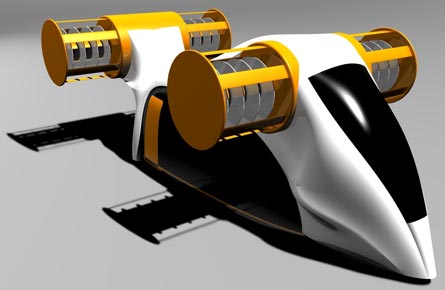One thing you will not get from an aeronautical research centre with a brief to "challenge research orthodoxy" to come up with "innovative solutions for the mobility of tomorrow" is instant results.
So it is with Bauhaus Luftfahrt - an institution set up five years ago with funding from the Bavarian government and three locally headquartered manufacturers, EADS, Liebherr and MTU, to devise radical answers to some of the most pressing problems of aviation, including the cost and availability of fuel and airport congestion.
Bauhaus Luftfahrt scientists are tasked with "thinking outside the box" on projects such as new aircraft concepts and alternative power that may not come to fruition for 20 to 30 years, often by adopting thinking from outside aviation. Its staff include those with a background in information technology, ecology, economics and geography as well as aeronautical engineering.
 Bauhaus Luftfahrt's unorthodox concepts include its 2D Propulsor |
|---|
Around the time that EADS was set up in 2000, European and German industry did some soul searching. There was a realisation that the aerospace sector excelled at developing existing technology and improving current products, but not at "eureka" thinking. "It was all about evolutionary rather than revolutionary thinking," says Müller-Wiesner. "We were very good at designing ever-better candles, but not at considering what would happen if someone invented electricity."
So Bauhaus Luftfahrt was created in 2005. Bauhaus means "building school" and the name hearkens back to the Weimar-based design movement of the 1920s, which challenged the then-orthodoxies of architecture and art.
Headquartered in Munich and with a director who is also the professor of aerospace at the city's technical university, the organisation has since then doubled its staff to 30, including 24 academics. It is currently working on around 25 industry-sponsored projects, plus another 20 or so more generic and long-term "basic research" studies - the real out-of-the-box thinking.
Research is split into five themes. Under radical air transport concepts are projects such as box wing designs, electrical aircraft, hybrid rotors for vertical take-off and landing, and lighter-than-air studies. Ecological perspectives for air transport takes in investigations into alternative fuel. Under future technologies are "disruptive technologies" such as nano-wire lithium batteries. Knowledge management looks at ways of leveraging intellectual capital by open collaboration, creating an "open source" community to develop a "conceptual aircraft design tool".
A final theme, socio-economic drivers for future air transport, aims to assess the effect of issues such as demographic change and environmental pressures on demand for flying.
Although Bavaria - the heartland of Germany's aerospace industry - has a reputation for acting independently from the rest of the country, Müller-Wiesner denies that Bahuaus Luftfahrt competes with or overlaps the work of Germany's aeronautics and space research centre DLR. While DLR is a "legacy" organisation "developed from classical aeronautical disciplines", Bauhaus Luftfahrt has "the ability to explore ideas when the research establishment is saying this will never fly", Müller-Wiesner says.
But perhaps a bigger difference is scale. While Bauhaus Luftfahrt has a staff of 30 and a budget of just over €4 million ($5 million) a year, DLR has 13 sites (including one of its biggest at Oberpfaffenhofen near Munich), employs 6,500 people and spends €570 million on its projects, not counting its space budget of €920 million.
As for those elusive hard results? Bauhaus Luftfahrt has published reports and papers and there are ongoing patent applications on technologies.
"We could soon see the first results towards a prototype," says Müller-Wiesner.
Source: Flight International
















